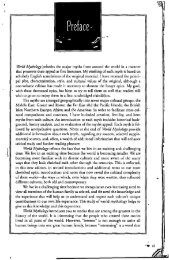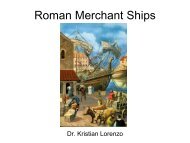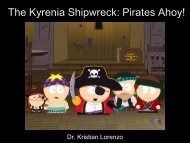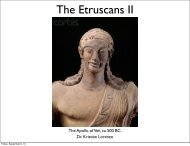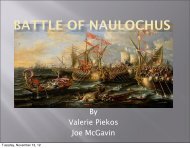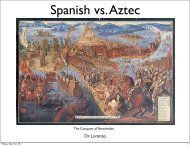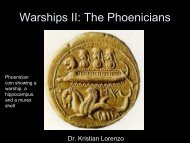The Late Roman and Byzantine Navies - Emmaf.org
The Late Roman and Byzantine Navies - Emmaf.org
The Late Roman and Byzantine Navies - Emmaf.org
You also want an ePaper? Increase the reach of your titles
YUMPU automatically turns print PDFs into web optimized ePapers that Google loves.
<strong>The</strong> <strong>Late</strong> <strong>Roman</strong> <strong>and</strong> <strong>Byzantine</strong> <strong>Navies</strong><br />
A <strong>Byzantine</strong> warship called a dromon.<br />
Dr. Kristian Lorenzo
<strong>Late</strong> <strong>Roman</strong> <strong>and</strong> <strong>Byzantine</strong> <strong>Navies</strong>: Today’s Topics<br />
<strong>The</strong> <strong>Late</strong> <strong>Roman</strong> Navy<br />
<strong>The</strong> Battle of the Hellespont<br />
<strong>Byzantine</strong> Warships<br />
<strong>The</strong> Dromon<br />
<strong>The</strong> Chel<strong>and</strong><br />
Greek Fire<br />
Constantinople<br />
<strong>The</strong> Harbor of <strong>The</strong>odosius
<strong>The</strong> Battle of the Hellespont, AD 324<br />
Consisted of two different naval clashes between Licinius’s<br />
fleet of 350 ships <strong>and</strong> Constantine’s of 200.<br />
Licinius’s<br />
Fleet<br />
2nd clash<br />
1st clash<br />
Constantine’s<br />
Fleet
<strong>The</strong> Battle of the Hellespont, AD 324<br />
Consisted of two different naval clashes between Licinius’s<br />
fleet of 350 ships <strong>and</strong> Constantine’s of 200.
<strong>The</strong> Battle of the Hellespont, AD 324<br />
Tapestry showing the Battle of the Hellespont between the Fleets<br />
of Constantine <strong>and</strong> Licinius. This tapestry dates to AD 1635.
<strong>The</strong> Battle of the Hellespont, AD 324<br />
<strong>The</strong> last great naval battle of antiquity<br />
An overwhelming victory for Constantine which:<br />
(a) shattered Licinius’s naval power<br />
(b) gave Constantine control of the Dardanelles, the<br />
Hellespont, the Bosphorus <strong>and</strong> the city of Byzantium<br />
(b) allowed Constantine to win the final l<strong>and</strong> engagement<br />
(c) made Constantine sole emperor of the <strong>Roman</strong> Empire<br />
(d) allowed Constantine to found Constantinople<br />
Both sides used ad hoc fleets. <strong>The</strong> empire no longer had<br />
st<strong>and</strong>ing fleets. <strong>The</strong>y were let waste away or were deemed<br />
too expensive with military spending focused on several<br />
large mobile armies.
<strong>The</strong> Battle of the Hellespont, AD 324<br />
Zosimus a 5th century AD historian in his New History tells us that:<br />
Licinius, hearing of the great preparations of Constantine, sent<br />
messengers to every nation, comm<strong>and</strong>ing them to prepare a sufficient<br />
number of men for the navy, besides horse <strong>and</strong> foot soldiers. <strong>The</strong><br />
Egyptians therefore sent out eighty galleys, the Phoenicians an equal<br />
number, the Ionians <strong>and</strong> Dorians of Asia sixty, the Cyprians thirty, the<br />
Carians twenty, the Bithynians thirty, <strong>and</strong> the Africans fifty.<br />
Constantine I<br />
Licinius <strong>and</strong> his son
<strong>The</strong> <strong>Byzantine</strong> Navy: Dromon<br />
<strong>The</strong> empire developed its own navy. <strong>The</strong> most important <strong>Byzantine</strong><br />
warship was the dromon, a fast light vessel.
<strong>The</strong> <strong>Byzantine</strong> Navy: Dromon<br />
<strong>The</strong> dromon had 2 or 3 masts with 2 levels of rowers, <strong>and</strong> a maximum crew<br />
of 300 which included at least 70 marines.
<strong>The</strong> <strong>Byzantine</strong> Navy: Dromon<br />
<strong>The</strong> dromon had a “wooden castle” or tower around its main mast from<br />
which marines discharged their spears, arrows, stones <strong>and</strong>/or pieces of<br />
metal.
<strong>The</strong> <strong>Byzantine</strong> Navy: Dromon<br />
Each dromon had a stern castle <strong>and</strong> a prow castle (elevated wooden decks<br />
with rails) upon which were set small ballistas able to fire projectiles.<br />
Stern<br />
castle<br />
Prow<br />
castle
<strong>The</strong> <strong>Byzantine</strong> Navy: Greek Fire<br />
Anna Komnena (late 11th century AD) in her book <strong>The</strong> Alexiad says, “<strong>The</strong><br />
emperor ordered the construction on all the ships of bronze <strong>and</strong> iron heads<br />
of lions <strong>and</strong> other wild animals, with open mouths....<strong>The</strong> liquid fire that was<br />
to attack the enemy would pass through the mouths of these heads, so that<br />
it would appear verily that they were vomiting forth flames.”<br />
Dromon with<br />
swiveling openmouthed<br />
animal<br />
head
<strong>The</strong> <strong>Byzantine</strong> Navy: Greek Fire<br />
Greek fire was most likely distilled petroleum mixed with pine resin <strong>and</strong><br />
perhaps also sulphur which was ignited <strong>and</strong> propelled by a pump out the<br />
prow animal’s open mouth. <strong>The</strong> recipe for Greek fire was one of the<br />
Empire’s state secrets.<br />
Dromon with<br />
swiveling<br />
openmouthed<br />
animal head
<strong>The</strong> <strong>Byzantine</strong> Navy: Greek Fire<br />
Callinicus (ca. AD 673) is credited with either discovering Greek fire or<br />
devising a much more effective variation thereof. A manuscript page<br />
showing 2 ousiakoi, lighter smaller vessels, adapted for rapid movements,<br />
<strong>and</strong> fitted with Greek fire.
<strong>The</strong> <strong>Byzantine</strong> Navy: Greek Fire<br />
On the ousiakos below a h<strong>and</strong>-held apparatus disg<strong>org</strong>es Greek fire, while<br />
on a dromon the apparatus would be larger <strong>and</strong> built into structure of the<br />
ship’s prow.
<strong>The</strong> <strong>Byzantine</strong> Navy: Not Just Greek Fire<br />
Texts speak of throwing baskets of live scorpions or snakes at enemies,<br />
<strong>and</strong> also projecting pots of powdered quicklime. Such pots formed a dust<br />
cloud which suffocated <strong>and</strong> blinded the enemy.
<strong>The</strong> <strong>Byzantine</strong> Navy: Greek Fire<br />
<strong>The</strong> use of Greek fire during naval battles seems to have stopped around AD<br />
1200. However, Mehmed II used not only Greek fire but also gunpowder <strong>and</strong><br />
cannons in his successful siege of Constantinople in AD 1453.<br />
Cannons
Constantinople <strong>and</strong> <strong>The</strong>odosius I, ‘the Great’<br />
<strong>The</strong> Emperor <strong>The</strong>odosius I, AD 379-408, built a large enclosed harbor on<br />
Constantinople’s southwest coast.
Constantinople <strong>and</strong> <strong>The</strong>odosius I<br />
<strong>The</strong>odosius’s harbor operated until the Lycos River completed filling it with<br />
silt in the 11th century AD.
Istanbul <strong>and</strong> the Yenikapi Excavations<br />
Excavations conducted by the Istanbul Archaeological Museum <strong>and</strong> the<br />
Marmaray Project for a metro stop in the area of Yenikapı in Istanbul have<br />
discovered the remains of <strong>The</strong>odosius’s harbor.<br />
In 2007, excavations included 50 archaeologists <strong>and</strong> 750 workers<br />
excavating in shifts 24 hours, 7 days a week, in an area the size of 10 city<br />
blocks.
Istanbul <strong>and</strong> the Yenikapi Excavations<br />
Excavations have uncovered a stratigraphic sequence for the last 8,500<br />
years <strong>and</strong> recovered artifacts from the Ottoman, <strong>Byzantine</strong>, <strong>Roman</strong>, Greek<br />
<strong>and</strong> Neolithic periods.<br />
Overhead view<br />
showing the<br />
remains of a 13thcentury<br />
<strong>Byzantine</strong><br />
church
Istanbul <strong>and</strong> the Yenikapi Excavations<br />
Other architecture uncovered includes a section of a dockside quay.<br />
<strong>The</strong>odosius’s harbor also included a breakwater, a large defensive tower<br />
<strong>and</strong> grain warehouses.
Istanbul <strong>and</strong> the Yenikapi Excavations<br />
To date 36 ship wrecks have been discovered mainly clustered on the<br />
eastern side of the harbor. Yenikapi ship wreck #1
Istanbul <strong>and</strong> the Yenikapi Excavations<br />
Yenikapi ship wreck #1 was loaded with pickled fry (a type of small fish)<br />
<strong>and</strong> almonds, walnuts, hazel nuts, muskmelon seeds, olives, peaches <strong>and</strong><br />
pine cones.<br />
Amphorae
Istanbul <strong>and</strong> the Yenikapi Excavations<br />
Yenikapi ship wreck #1: the inner hull is separated from the outer hull by a<br />
large number of frame timbers. <strong>The</strong> frame-first technique is employed with<br />
bronze nails.
Istanbul <strong>and</strong> the Yenikapi Excavations<br />
Most of the 36 ship wrecks are of commercial ships. However, 6 warships<br />
have also been identified.
Istanbul <strong>and</strong> the Yenikapi Excavations<br />
A total of 190,000 artifacts have been recovered including many ceramic oilburning<br />
lamps.
Istanbul <strong>and</strong> the Yenikapi Excavations<br />
A total of 190,000 artifacts have been recovered including tons of pottery both<br />
fully complete <strong>and</strong> partially intact vessels.
Istanbul <strong>and</strong> the Yenikapi Excavations<br />
Other artifacts include a bronze scale <strong>and</strong> a scale weight in the shape of<br />
Athena.
Istanbul <strong>and</strong> the Yenikapi Excavations<br />
Still other artifacts include wooden bath clogs <strong>and</strong> wooden<br />
combs.
<strong>The</strong> Yenikapi Transfer Point <strong>and</strong> Archaeo-park<br />
Once excavations are complete Yenikapi will have an archives complex<br />
with circular display spaces, a metro stop/transfer point <strong>and</strong> an archaeopark.<br />
http://vimeo.com/41416166
<strong>The</strong> Yenikapi Transfer Point <strong>and</strong> Archaeo-park
Istanbul <strong>and</strong> the Yenikapi Excavations: Importance<br />
now know the exact size, position <strong>and</strong> layout of <strong>The</strong>odosius’s<br />
harbor<br />
fantastic example of urban rescue archaeology with integration of<br />
an archaeological site into the fabric of a modern city<br />
new information about daily life in Constantinople<br />
new information about dietary habits, commodities shipped, ship<br />
building techniques, amphora types, geographical extent of trade,<br />
etc.<br />
physical evidence for how a <strong>Byzantine</strong> warship was constructed<br />
the largest number of <strong>Byzantine</strong> warships recovered anywhere,<br />
since such ships are derived from earlier <strong>Roman</strong> <strong>and</strong> Greek<br />
warships they will give a much needed window on the earlier ship<br />
types.





